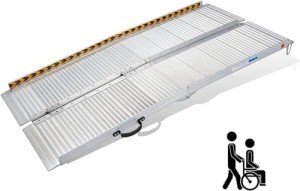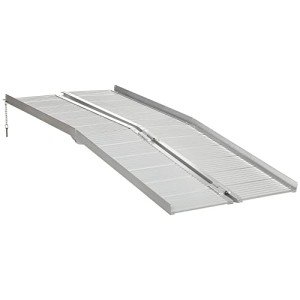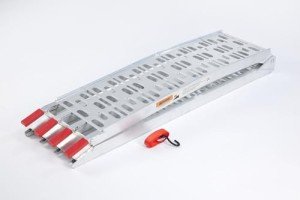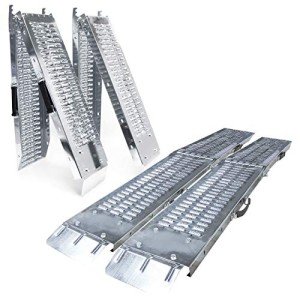Loading ramps are vital tools for transporting motorcycles, bicycles, ATVs, and other equipment, especially when dealing with vans or vehicles lacking a low loading height. Heavy-duty folding loading ramps have gained popularity for their convenience and durability, catering to professionals and recreational users alike. This guide examines the criteria for selecting heavy-duty loading ramps, their advantages, types, maintenance tips, and answers to common questions.
Why Use Heavy-Duty Folding Loading Ramps?
Heavy-duty folding loading ramps are designed to support significant weight while providing stability and safety during loading and unloading operations. These ramps typically consist of robust materials like aluminum or steel, ensuring longevity even under frequent use.
Advantages:
- Weight Capacity: Heavy-duty ramps accommodate a wide range of weights – usually between 1,000 to 2,500 lbs – allowing them to handle most motorcycles and bicycles safely.
- Portability: Folding designs allow for easy storage and transport, making them excellent for mobile users.
- Versatile Use: Suitable for various vehicles, including cargo vans, pickup trucks, and trailers, thus maximizing flexibility.
- Anti-Slip Features: Many ramps feature rubberized surfaces or grip strips to enhance traction, minimizing slip accidents during use.
- Durability: Constructed from robust materials, they are weather-resistant and designed to withstand constant usage.
Factors to Consider When Selecting Heavy-Duty Folding Loading Ramps
When investing in heavy-duty folding loading ramps, consumers should consider several factors to ensure they select a model that meets their needs effectively.
1. Weight Capacity
Choose a ramp that can handle the weight of the heaviest item you’ll be loading consistently. It's wise to select a ramp with a capacity exceeding your expected weight to ensure safety.
2. Ramp Length
Longer ramps (generally 6 to 12 feet) create a gentler incline, making it easier to load heavy items without excessive effort. However, consider your vehicle's height and available space when choosing a length.
3. Material
Ramps made from aluminum provide a good balance of weight and strength, often being lighter while still supporting heavy weights. Steel ramps may offer more durability but can be heavier.
4. Folding Mechanism
Check how the ramp folds and unfolds. A simple, robust mechanism is essential for quick and easy use.
5. Price
Ramps can vary greatly in price based on material and features. Establish your budget while considering that cheaper options may not always provide the necessary safety and durability.
6. Safety Features
Look for ramps with essential safety features such as:
- Rubberized grips preventing slipping.
- Safety straps to secure the ramp to your vehicle.
- Side rails to prevent the bike or object from rolling off.
Summary Table: Key Features of Heavy-Duty Folding Loading Ramps
| Feature | Considerations |
|---|---|
| Weight Capacity | Usually ranges from 1,000 to 2,500 lbs |
| Ramp Length | Longer ramps create less incline (6 to 12 feet). |
| Material | Aluminum (lightweight) or Steel (heavy-duty) |
| Folding Mechanism | Simple and robust for easy usage |
| Safety Features | Rubberized grips, safety straps, and side rails |
Maintenance Tips for Heavy-Duty Loading Ramps
Proper maintenance ensures longevity and safety when using loading ramps. Here are a few tips:
- Regular Inspection: Regularly check for damages, such as cracks or corrosion in metal ramps, and any wear on the grip surfaces.
- Clean After Use: Wipe down the ramp with a damp cloth to remove dirt and debris that can affect traction.
- Store Properly: Keep ramps stored in a dry, cool place when not in use, and avoid placing heavy items on top, which might cause warping.
- Lubricate Hinge Mechanisms: Periodically lubricate any hinges or folding mechanisms to ensure smooth operation.
- Follow Weight Guidelines: Respect the manufacturer’s specified weight limits to avoid damage or accidents.
FAQs About Heavy-Duty Folding Loading Ramps
Q1: What are heavy-duty folding loading ramps made of?
A: Heavy-duty ramps can be constructed from either aluminum, which is lightweight and rust-resistant, or steel, which is heavier but typically more durable.
Q2: How do I choose the right length for my loading ramp?
A: The length of the ramp should be dictated by the height of your vehicle's loading area. Longer ramps create a gentler incline, facilitating easier loading.
Q3: Can I use these ramps for different vehicles?
A: Yes, heavy-duty folding loading ramps are versatile and can be used with a variety of vehicles including vans, trucks, and trailers.
Q4: Are heavy-duty ramps safe for regular use?
A: Yes, provided they are used according to the manufacturer’s guidelines and have features such as anti-slip surfaces and secure fastening options.
Q5: How much does a heavy-duty loading ramp typically cost?
A: Prices vary widely based on length, weight capacity, and material but generally range from £100 to £500.
Investing in a heavy-duty folding loading ramp can significantly enhance the efficiency and safety of transporting bikes and other heavy equipment. By considering weight capacity, material, length, and safety features, users can find a ramp suitable for their specific needs. Regular maintenance and adherence to guidelines will ensure these ramps provide reliable service for years to come.






